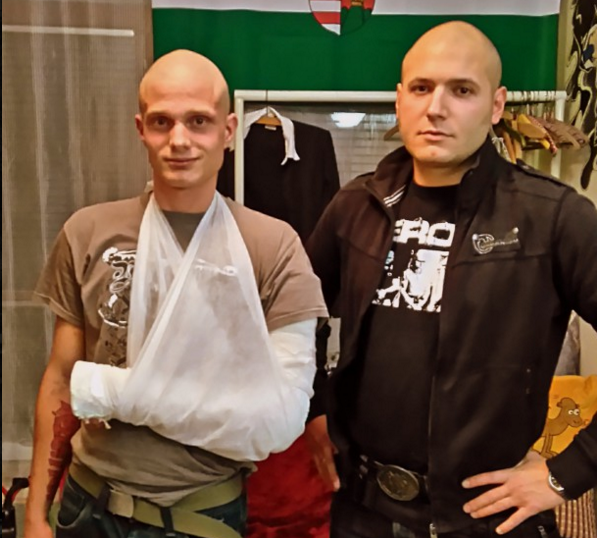The Alfahír website, closely associated with Hungary’s Jobbik party, ran a story about a peaceful young man who was brutally assaulted on the streets of Budapest on October 23rd, a national holiday, apparently for no other reason than for being a Hungarian “patriot.” He was beaten up by a group of seven men and women, who Alfahír reported were of Roma origin, and who apparently taunted their victim because of his overt displays of patriotism. The story, written by Jobbik journalist Adrián Magvasi, was entitled “Take that, you proud Hungarian! – Gypsies beat up a young man on the national holiday,” and the headline was clearly meant to have maximum impact. Unfortunately, the title and the article itself were both misleading, although it does speak volumes about Jobbik’s new and more cautious communication on issues of ethnicity and identity.
According to the Alfahír piece, a young man was walking down the street in the Budapest working class suburb of Kőbánya on the day when Hungarians commemorate the 1956 Revolution. He was dressed in such a way that others could easily identify him as being a “patriot.” I was not sure what this meant, as Mr. Magvasi was tight-lipped on what exactly the unnamed young man was wearing. Was it a small flag on his lapel, or perhaps a pin, in the shape of Hungary’s national crest? Millions of Hungarians, of all political stripes, wear those on national holidays and there is nothing unusual about that at all.
According to Mr. Magvasi’s account, this is what happened:
“Three young Gypsies blocked his way on the street, then followed and provoked him. ‘You rotten skinhead, you dirty fascist’ and why are you so proud of your ‘filthy Hungarian peasantry?’ The boy wore Hungarian national symbols on his clothing and responded that he was proud of his Hungarian identity, at which point the Gypsies called for their relatives. There were seven or eight of them, including a larger, forty-something year old man with a wooden stick. They attacked him immediately and he tried to defend himself with his hands. ‘Take this, you proud Hungarian!’–yelled the man, as he tried to stab the boy, multiple times, with the sharper points of his broken stick, while another struck the boy on the head.”
The unnamed young man was taken to hospital and was treated for injuries, some of which required minor surgical intervention. Mr. Magvasi included a cryptic photo of the victim, but all it showed was an arm in a cast, covering a shirt that seemed to have Gothic lettering. Although little of it could actually be seen, it somehow reminded me of the sort of slogans and wording found on apparel worn by neo-Nazis. The article, however, linked into a more detailed interview with the young man, published on the website of the unabashedly far-right Sixty-Four Counties Youth Movement (HVIM), which did not undergo the sort of public relations make-over that Jobbik did over the past 18 months.
It became immediately clear from this article that the young man was a proud skinhead and that it wasn’t just some display of Hungarian patriotism that set off his attackers, nor did his attackers call him a fascist and skinhead without reason.

The victim of the attack in Kőbánya (left) standing with another skinhead, Béla Incze, vice president of the Sixty-Four Counties Youth Movement.
Additionally, the interview suggests something that is not present in Mr. Magvasi’s article. Before the physical assault, the young skinhead provoked his attackers by saying “Here, I am at home.” The order of the words in Hungarian is important (“itt én vagyok otthon“), because it very clearly states that while this is the skinhead’s homeland, the Roma who confronted him are foreigners.
None of these details should, in any way, excuse the violence perpetrated by this group of hooligans. But the fact that Mr. Magvasi, Alfahír’s editor-in-chief, sanitized the story for publication in Jobbik’s main news site speaks volumes about how the far-right party is seeking to clean up its image. It also demonstrates what most observers of Hungarian politics know: Jobbik only cleaned-up and fine-tuned its message at the national level. Below the surface, skinheads, neo-Nazis and fascists continue to dominate.
The 27 year old Mr. Magvasi also ran as the Jobbik candidate in a municipal by-election held this past September, in Budapest’s left-leaning 13th District. As could be expected, the Hungarian Socialist Party (MSZP) candidate won by a wide margin (with 60% of the votes) and Mr. Magvasi garnered just 9%. But Mr. Magvasi, a clean-cut, soft-spoken and seemingly moderate young man in a suit, is the savvy “new” image that Jobbik wants to project at the national level. In a three minute introduction granted to him and to all candidates by a local Budapest television station, Mr. Magvasi said nothing that could be construed as more extreme than the politics represented by Fidesz, including on issues such as the refugee crisis. In fact, he maintained a more civilized tone than most government politicians. I have also exchanged a few emails with Mr. Magvasi on a couple of occasions. He’s polite, well-spoken and responsive to queries.
And he also has a job to do within Jobbik, as the far-right party seeks to make itself more presentable to a wider audience.



